Planting Ideas to Create a Garden for the Senses
March 21st, 2024 | Categories
While all gardens appeal to our senses in some way, sensory stimulation in gardening, or ‘sensory gardens’ are gardens designed to rouse some or all of our five senses through scent, sight, sound, taste, and touch. Plants are, of course, at the heart and soul of sensory gardening. Each plant introduced is chosen for its ability to stimulate one or more sense in a delightful way. They are fantastic because they can do this in multiple ways.
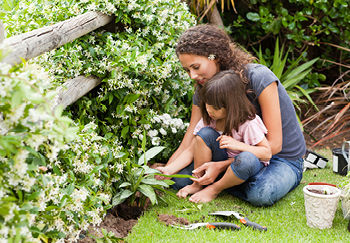
They offer a complete range of colours and textures with a bonus that many will change throughout the seasons, giving year-round interest. On top of that, many plants give us wonderful scents from their blooms, some can be touched to experience their unique textures, or promote a lovely aromatic scent when rubbed gently, and then there are those we can harvest to eat. Plants also attract pollinators like bees and butterflies to the garden, adding another sensory level of seeing nature at work in the garden.
There are plenty of plants that offer excellent sensory experiences. In this guide, we will take you through a variety of plants that are not only easy to grow and care for, but have fantastic sensory benefits.
Sensory Garden Plant Ideas
Here are our top plants for sensory gardens that will awaken the senses, and sooth the mind:
English Lavender
Known for its calming aroma, Lavender is a must-have plant in sensory gardens (and we think generally too). Its purple flowers not only provide visual stimulation but touching its leaves releases its distinctive and relaxing scent, providing an aromatic and tactile treat for gardeners. Lavender also attracts an abundance of bees and butterflies, adding a great visual and auditory layer to the sensory experience.
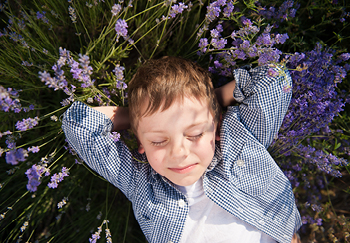
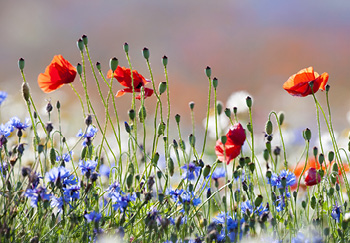
Wildflowers
Wildflowers are a delightful and practical addition to sensory gardens. They create a kaleidoscope of colours and shapes that provide visual stimulation, and their differing textures are interesting to the touch.
Wildflowers such as Cornflowers, Poppies, and Oxeye Daisies carry distinct scents too, while others, like the Elderflower, can be used in making cordials or cakes, adding a taste element to the sensory experience. Their ability to thrive with minimal care is another bonus on top for the busy gardener.
Herbs
Herbs are another top choice. Many types of herbs grow for large parts of the year, offering gentle scent as well as a great taste. Popular choices include basil, coriander, parsley, chives, mint, rosemary, and thyme. A lot of herbs need a sunny spot to grow and even a south facing windowsill in the house also works well. Introduce some herbs and you’ll be gently running your hands through them daily, as well as picking when needed for home cooking.
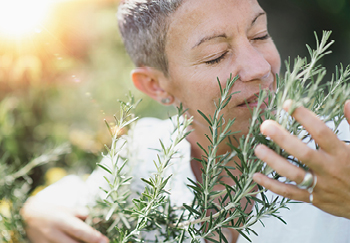
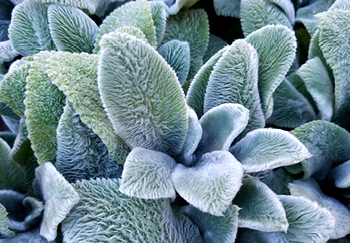
Lamb’s Ear
Lamb’s Ear is renowned for its velvety, soft leaves that resemble the texture of a lamb’s ear, this plant offers a unique tactile experience in any sensory garden. Its silvery-green foliage also adds visual interest to the garden. Moreover, during late spring and early summer, Lamb’s Ear produces spikes of pinkish-purple flowers that not only add to the garden’s visual appeal but also attract a variety of pollinators such as bees and butterflies.
Black-eyed Susan
This cheery flower is a sensory delight with its bright yellow petals and dark, black-eyed centre, providing a feast for the eyes. The sturdy texture of the petals adds a unique tactile experience, and its ability to attract various insects and birds brings an auditory aspect to the sensory garden. Its bright yellow petals remind us of the sun, giving us feelings of warmth, energy, and happiness, as well as hope and fun too.
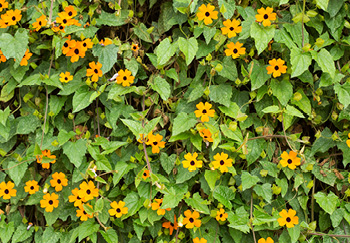
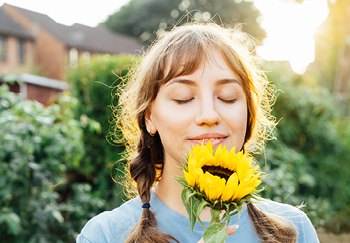
Sunflowers
Sunflowers are such a happy looking plant, and with their towering height and vibrant yellow petals, they make for a superb visual treat in a sensory garden. Their rough, thick stalks provide a textural experience, and the seeds that form can be harvested in the late summer, making for a tasty snack.
Additionally, sunflowers are a magnet for a variety of birds, which are relaxing to watch and while doing so brings a focus to our minds and reducing stress.
Marigolds
A sensory garden would be incomplete without the lively presence of marigolds. Their bold and vibrant colours – ranging from yellow and gold to orange and red – provide a feast for the eyes and rouse the parts of our brains that bring joy. The distinct aroma of marigolds, both intriguing and potent, is a unique addition to the olfactory experience.
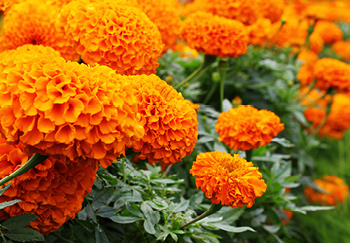
Apart from their sensory appeal, marigolds are known to deter pests organically, making them not just aesthetically pleasing, but also a practical addition to your sensory garden.
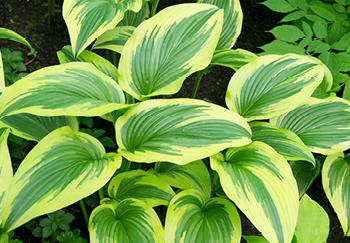
Hostas
Known for their lush, green foliage and varying leaf textures, Hostas are a fantastic choice. They stimulate the sense of touch with their ribbed leaves, and some varieties produce fragrant flowers, which adds to the garden’s scent experience. Their visually appealing foliage green-hued foliage provides a feast for the eye. Hostas are also hardy and quite shade-tolerant, making them another practical choice for many garden locations that don’t get a lot of sun.
Sedum
Sedums offer a unique sensory experience with their fleshy, succulent leather feeling leaves. They come in a variety of colours, from greens and blues to vibrant reds and yellows, making them a visual delight. During late summer and autumn, sedums bloom with clusters of star-shaped flowers, adding to the visual appeal and attracting a variety of insects.
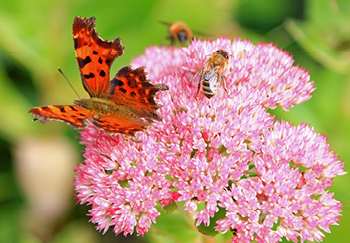
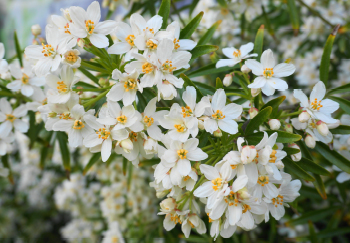
Choisya
Choisya, or Mexican orange blossom, is a great choice for any garden visually, but also for its dual scent. Its glossy, evergreen leaves are scented and when rubbed give off a basil-like smell. The bright star-shaped white flowers that bloom in spring, give off a lovely, sweet scent too. On top of that they’re brightly coloured and easy to grow and also do well in containers.
Geranium
Geraniums are a fantastic choice, offering a feast for multiple senses. Their vibrant, round flower heads in shades of pink, purple, blue, and white are a visual delight. The leaves of some varieties release a distinct, uplifting aroma when touched too, engaging the sense of smell.
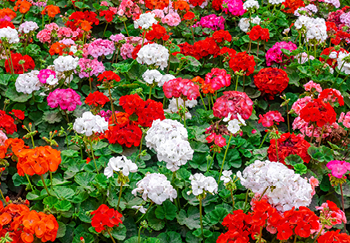
Geranium leaves also offer a unique texture, ranging from smooth to deeply lobed, providing tactile interest. Plus, geraniums are a favourite among butterflies, adding an auditory element to the sensory garden with their fluttering wings and a great connection to nature.
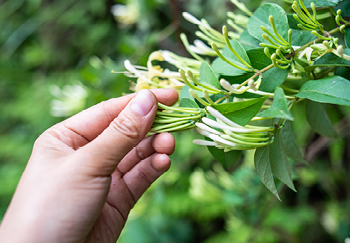
Honeysuckle
This vigorous climber is a glorious addition to any sensory garden. Renowned for its sweet, heady fragrance, Honeysuckle delights with its scent which is particularly strong in the evening. The tubular flowers, which bloom in a variety of hues including yellow, white, and sometimes pink, provide a visual treat.
With edible varieties the nectar can be sucked from the bottom of the flower, adding a sweet flavour to the sensory experience. Moreover, the plant is a magnet for bees and other pollinators, which are a delight to hear around the garden with their gentle humming.
Sweet Peas
Another excellent choice are Sweet Peas. Charming to look at, and fragrant to boot. Sweet Peas have vibrant blossoms in shades of pink, purple, red, white, and even blue. In any garden they’ll give a stunning visual display, taking your mind away from the stresses of day to day.
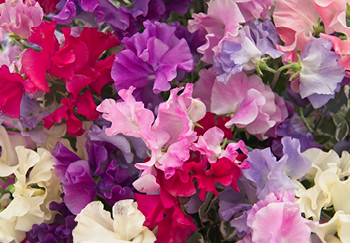
The flowers’ sweet perfume is particularly strong in the early morning and late evening, providing a delightful start and finish to the day. Their soft, yet firm petals can be gently touched too and being tall they’ll sway nicely in the summer winds.
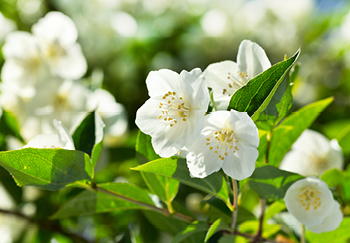
Jasmine
Known for its intoxicatingly sweet fragrance, jasmine is a delight in any sensory garden. The plant’s delicate, star-shaped flowers are a feast for the eyes, typically blooming in shades of white or yellow. Jasmine flowers at night, releasing its potent aroma and making it an exciting addition for those twilight garden visits.
Cyclamen
Cyclamen plants are a visual treat with their beautiful, heart-shaped leaves and elegant, swept-back flowers in shades of pink, white, or purple. Its unique flower shape and leaf patterns provide visual interest, and its soft petals offer a tactile stimulant. Some species of Cyclamen also have a delicate, sweet scent.
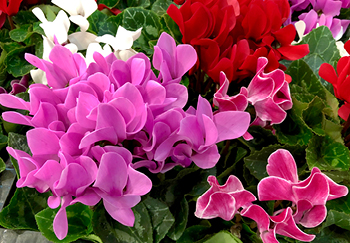
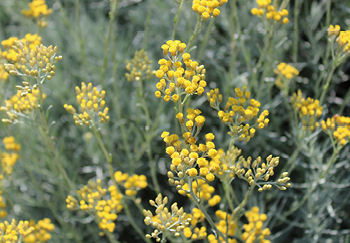
Curry Plant
The Curry Plant, with its silver-grey leaves and yellow flowers, is an exceptional addition to a sensory garden. Its leaves, when crushed, release a strong aroma that is reminiscent of – you guessed it – curry. The yellow clusters of flowers that bloom in mid to late summer not only add to the visual appeal of the garden, but also attract a variety of pollinators.
Ornamental Grasses
The graceful swaying of ornamental grasses such as Miscanthus, Panicum, or Pennisetum adds a dynamic and tactile element to a sensory garden. Their feathery plumes, in shades of bronze, silver or gold, provide visual interest throughout the year.
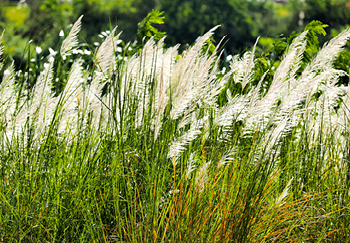
The rustling sound of their leaves in the breeze brings an auditory aspect to the sensory garden. When touched, these grasses offer a range of textures, from the silkiness of Maiden Grass to the roughness of Blue Fescue. Some grasses, like Sweetgrass, even carry a pleasant, vanilla-like scent when their leaves are crushed.
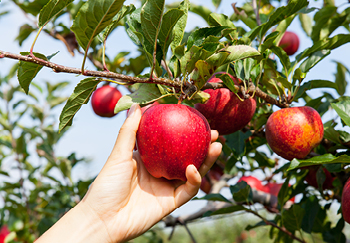
Apple Tree
Adding a dwarf apple tree creates a wonderful focal point that appeals to all the senses throughout the seasons. In spring, the delicate blossom releases a light, sweet scent and provides a stunning visual display. As the fruits develop, they offer an evolving feast for the eyes, and eventually, the taste buds.
The rich textures of apple tree bark and leaves add further tactile elements to explore. Moreover, the gentle rustling sound of leaves and the variety of birds that apple trees attract will enhance the auditory experience within the garden.
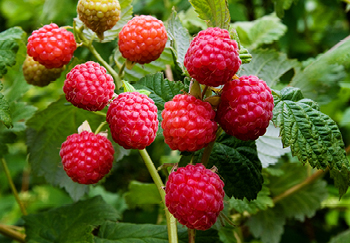
Other Fruits
Raspberries, blackberries and strawberries together make a delightful trio in a sensory garden. Their vibrant red and deep purple hues offer visual stimulation, while their distinct, sweet scents engage the olfactory senses. The texture of their leaves and ripe fruit provides a variety of tactile experiences.
Let’s be honest though, it’s all about the taste! Their ripe, freshly picked fruit is unmatched, adding a great taste and fun element to the sensory experience.
What Plants Will You Choose for Your Garden?
With a few additions here and there, you can maximise the sensory experience of your garden, enabling you to better tune into your surroundings, connect with nature, and bask in the positive effects provided. In a short time, your garden can become a place of serene enjoyment, and a perfect escape from the stresses and speed of the world today. If you’re looking for advice on how to create a sensory garden, our other guide offers great guidance to do just that.






